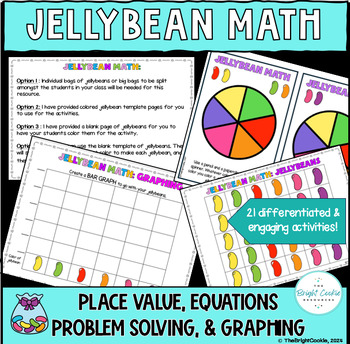Jellybean Math: K-4th grade - Place Value, Graphing, Problem Solving, Fractions
- PPTX
Description
This resource includes 31 pages and 10 differentiated and engaging activities. All the activities/pages in this resource are standards based. You can use this in spring around Easter (however, it isn’t not Easter related), or ANY time in the year in which you want to review graphing, place value, problem solving, equations/computation, and fractions. This product can be used as stations OR whole group activities.
*If you would like to use real jellybeans for this activity, GO FOR IT! (We all know that kiddos seem to be more apt to learn when food is involved!) However, with the rules today about food in the classroom, I have provided jellybean templates as well.
Jellybean templates:
1. 30 colored jellybeans that match the colors of the jellybeans in the activity.
2. 30 blank jellybeans to have your students color in the beans the color of teacher’s choice.
3. 60 blank jellybeans for group use.
4. A page that has (2) spinners on it to laminate and have students use to spin and color the beans before the activity.
*Place Value Jellybean Math: There are 4 differentiated levels provided for this activity. Level 1-4. Each level increases in difficulty. Level one would be appropriate for kindergarten and first grade students, and so on.
-There is also a blank template with blanks for the colors and values of the, so the teacher can fill in what colors/values he/she prefers.
*Equations Jellybean Math: There are 4 differentiated levels provided for this activity. Level 1-4. Each level increases in difficulty.
Level one: 1-digit + 1-digit addition.
2: Multi-digit addition
3: Multiplication: (1-digit by 1-digit), (3-digit by 1-digit), (2-digit by 2-digit)
4. Addition (4-digit by 4-digit), Subtraction (4-digit by 4-digit), and Multiplication
(3-digit by 1-digit), (4-digit by 1-digit), and (2-digit by 2-digit).
*A recording sheet with room to show work is provided.
*Another page with the graph labeled with colors is provided, but the rest of the page is left blank for teacher to create his/her own equations for the students to solve.
*The final page is provided with an empty graph (no specific colors provided) and the rest of the page blank for teacher to fill in the activity how he/she desires.
*Graphing: There are 3 differentiated levels for this activity. The graphing part of this resource includes bar graphs (3 versions), frequency table, and dot plot. The three different levels are a part of the bar graph. There is a colored version with blank labels, 2 different levels of difficulties of the other bar graph versions.
*There is also a frequency and dot plot page.
*Jellybean Problem Solving: This part of the resource is higher-level. It has to do with finding the product of jellybeans. Putting jellybeans in greatest to least order and creating a word problem of his/her own. A page with specific colors is provided as well as a page that has blanks for the colors.
*Fractions:
-There is a page with questions that are labeled with specific colors.
- A page with blanks for the colors so that the teacher can fill it in how he/she chooses to.
If you like this resource, here are some other math resources from my store:
Area and Perimeter: Review and Test Prep Stations
Strip Diagrams and Multi-Step Problems: Review and Test Prep Stations
Headbands: Place Value Vocabulary Review Game
Headbands: Geometry Vocabulary Review Game
Headbands: Financial Literacy Vocabulary Review Game





